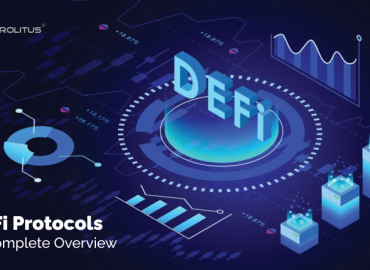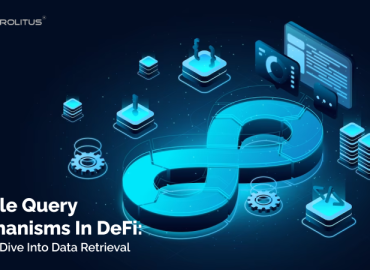Introduction to Automated Market Maker (AMM) Protocols in DeFi
Decentralized Finance (DeFi) has rapidly transformed the financial landscape by offering a permission less and trustless ecosystem for users to engage in various financial activities. At the heart of this revolutionary movement are Automated Market Maker (AMM) protocols, which have played a pivotal role in enabling efficient and seamless token trading and liquidity provision.
Traditional financial systems heavily rely on centralized intermediaries such as banks and exchanges to facilitate transactions and provide liquidity. However, AMM protocols disrupt this centralized model by leveraging smart contracts and blockchain technology to create decentralized liquidity pools. These pools allow users to trade digital assets directly with the pool, rather than relying on order books and order matching as seen in traditional exchanges.
The core concept of AMM protocols is to use mathematical algorithms to determine asset prices based on the available liquidity within the pool. This eliminates the need for order books and enables continuous liquidity provision. As a result, users can trade assets 24/7 without the need for a centralized intermediary, enhancing accessibility and eliminating counterparty risk.
In this blog, we will explore the technical components that constitute a robust AMM protocol and the essential design considerations that developers must take into account when building such systems. From liquidity pool mechanisms to pricing functions, from impermanent loss mitigation to gas efficiency, we will delve into the intricacies of creating an effective and secure AMM protocol.
Furthermore, we will examine some of the popular AMM protocols in the DeFi space and compare their approaches to liquidity provision and trading mechanisms. By understanding the various design choices and trade-offs, we can gain valuable insights into the strengths and limitations of different AMM implementations.
As the DeFi ecosystem continues to evolve, AMM protocols are poised to play a critical role in enabling financial inclusion and fostering innovation. By comprehending the fundamental principles behind AMMs and exploring the challenges they face, we can paint a clearer picture of the future of decentralized finance and the potential it holds for reshaping the global financial landscape. Let’s embark on this journey to uncover the inner workings of AMM protocols and appreciate their significance in the exciting world of DeFi.
Technical Components of an AMM Protocol
The technical components of an Automated Market Maker (AMM) protocol form the backbone of its functionality. These components are responsible for managing liquidity, calculating asset prices, executing trades, and ensuring the protocol’s overall efficiency and security. Below are the key technical components of an AMM protocol:
- Liquidity Pool Contract: The liquidity pool contract is the heart of the AMM protocol, where funds are deposited by liquidity providers. It holds the reserves of each token in the trading pair and manages the liquidity available for swaps. Users interact with this contract to trade assets, add liquidity, or withdraw their share of the pool.
- Pricing Function: The pricing function is a mathematical formula used to determine the exchange rate of one token for another within the liquidity pool. Commonly used functions include the Constant Product Market Maker (CPMM) formula used in Uniswap (x * y = k), and the Constant Sum Market Maker (CSMM) formula used in Balancer. This function ensures that the product of the reserves of the two tokens remains constant, maintaining a balanced pool.
- Swap Mechanism: The swap mechanism allows users to exchange one token for another within the liquidity pool. When a swap request is initiated, the AMM protocol uses the pricing function to calculate the number of tokens to be received by the trader based on the current pool reserves.
- Liquidity Provision Mechanism: To become a liquidity provider, users deposit an equal value of both tokens into the liquidity pool. The liquidity provision mechanism calculates the proportional share of the pool that each liquidity provider owns. In return, LPs receive fees from trades executed in the pool.
- Gas Optimization: AMM protocols need to be gas-efficient to minimize transaction costs for users. Gas optimization involves implementing algorithms and contract structures that reduce the computational complexity and the number of on-chain operations required for each transaction.
- External Price Oracles: Some AMM protocols rely on external price oracles to obtain real-time price information about the tokens in the pool. These oracles help ensure that the asset prices used for swaps are accurate and up-to-date.
- User Interfaces (UIs): While not strictly a technical component within the protocol contract itself, user interfaces (UIs) play a crucial role in enabling users to interact with the AMM protocol. These interfaces allow traders and liquidity providers to access the protocol’s functionality easily.
- Security Mechanisms: AMM protocols must implement robust security mechanisms to protect user funds and prevent attacks such as front-running and liquidity draining. Security audits and code reviews are essential steps in ensuring the protocol’s integrity.
By effectively integrating these technical components, AMM protocols provide a decentralized and efficient way for users to trade tokens and participate in liquidity provision, driving the growth and adoption of decentralized finance (DeFi) platforms.
Design Considerations for Building an Effective AMM Protocol
Building an effective Automated Market Makers (AMMs) in DeFi space requires careful consideration of various design aspects. Below are key design considerations to ensure the protocol’s efficiency, security, and user-friendliness:
- Impermanent Loss Mitigation: AMMs often expose liquidity providers to impermanent loss, which occurs when the value of deposited tokens changes relative to the external market. Designing mechanisms to mitigate impermanent loss or offering additional incentives for liquidity providers can attract more participation and ensure long-term sustainability.
- Optimal Pricing Function: Selecting an appropriate pricing function that suits the specific use case of the AMM is crucial. Different pricing functions (e.g., CPMM or CSMM) have their strengths and weaknesses, and the chosen function should align with the protocol’s goals and trading pairs.
- Gas Efficiency: Optimize the protocol’s smart contract code and algorithms to reduce gas costs. High gas fees can deter users from engaging with the AMM, so minimizing gas usage is essential for creating a user-friendly experience.
- Liquidity Bootstrapping Mechanisms: To ensure a liquid market from the start, consider incorporating liquidity bootstrapping mechanisms, such as liquidity mining, yield farming, or initial liquidity offerings (ILOs). These mechanisms incentivize users to provide liquidity and jumpstart the protocol’s adoption.
- Dynamic Fee Mechanisms: Consider implementing dynamic fee mechanisms to adjust transaction fees based on market conditions. Lower fees during times of high volatility and higher fees during periods of stability can incentivize liquidity provision and maintain stable operations.
- User Experience (UX): An intuitive and user-friendly interface is crucial for encouraging user adoption. Design the user interface with simplicity and clarity in mind, allowing users to easily navigate and interact with the AMM.
- Oracle Integration: Ensure reliable and accurate price oracles for real-time asset price updates. Properly integrating oracles helps prevent manipulation and ensures that the AMM uses the most up-to-date prices for trading.
- Interoperability and Token Standards: Consider compatibility with various token standards (e.g., ERC-20, ERC-721) to allow seamless integration with other DeFi protocols and applications. Interoperability can enhance the protocol’s utility and expand its reach.
By carefully considering these design aspects during the development of an AMM protocol, DeFi projects can create efficient, secure, and user-friendly platforms that contribute to the growth and success of the decentralized finance ecosystem.
Popular AMM Protocols: A Comparative Analysis
In the decentralized finance (DeFi) ecosystem, several Automated Market Maker (AMM) protocols have gained popularity due to their unique features, liquidity provision mechanisms, and community support. Let’s conduct a comparative analysis of some of the most popular AMM protocols:

- Uniswap:
Uniswap is one of the pioneering and most widely used AMM protocols. It operates on the Ethereum blockchain and utilizes the Constant Product Market Maker (CPMM) formula. Uniswap offers simple and user-friendly token swapping with a wide range of ERC-20 tokens. It gained significant adoption due to its ease of use and became a cornerstone in the DeFi space.
- SushiSwap:
SushiSwap is a fork of Uniswap and was created with the goal of enhancing liquidity provider rewards. It introduced the concept of “yield farming,” where users can earn governance tokens (SUSHI) as incentives for providing liquidity to the protocol. SushiSwap’s community-driven approach and innovative features have helped it gain a loyal user base.
- PancakeSwap:
It is often referred to as the “Uniswap of BSC.” PancakeSwap gained traction due to its lower transaction fees compared to Ethereum-based protocols, making it a popular choice for users looking for cost-effective swaps and liquidity provision.
- Balancer:
Balancer is a more complex AMM protocol that allows for multiple token pairings within a single liquidity pool. This feature, known as “smart pools,” enables LPs to provide liquidity for multiple tokens simultaneously and earn fees proportionate to their share in the pool. Balancer provides greater flexibility for liquidity providers and traders seeking exposure to multiple assets.
- Curve Finance:
Curve Finance is a specialized AMM protocol designed for stablecoin trading with low slippage. It focuses on optimizing trades between stablecoins, making it ideal for users looking to swap stablecoins with minimal price impact. Curve Finance has gained popularity as a reliable platform for stablecoin liquidity.
Comparative Factors:
- Token Availability: Evaluate the range of tokens available for swapping and liquidity provision. Some protocols offer a broader selection of tokens, while others focus on specific assets or stablecoin pairs.
- Liquidity Provision Mechanisms: Consider the incentives and rewards offered to liquidity providers. Some protocols offer additional governance tokens, farming rewards, or other incentives to attract liquidity providers.
- Security and Audits: Check for security audits and the history of the protocol’s security. Well-audited protocols inspire more confidence in users.
- Gas Fees and Scalability: Assess the gas fees associated with transactions on the protocol. Protocols operating on Ethereum may face higher fees during times of network congestion, while BSC-based protocols generally offer lower fees.
- Community and Governance: Analyze the strength and activity of the protocol’s community. Robust governance mechanisms can lead to protocol upgrades and improvements driven by community consensus.
Each of these AMM protocols has its strengths and caters to different user preferences. As the DeFi landscape continues to evolve, new AMM protocols and innovations are likely to emerge, providing users with even more options and opportunities for decentralized trading and liquidity provision.
Testing and Auditing AMM Protocols: Best Practices
Testing and auditing are critical steps in ensuring the security, functionality, and reliability of an Automated Market Maker (AMM) protocol. Below are best practices for testing and auditing AMM protocols:
- Automated Testing: Implement comprehensive automated testing suites to cover various aspects of the AMM protocol. Use unit tests, integration tests, and end-to-end tests to validate the correctness of smart contract logic and interactions.
- Stress Testing: Conduct stress testing to evaluate the protocol’s performance under extreme conditions. Test scenarios with high volumes of transactions, liquidity changes, and concurrent user interactions to identify potential bottlenecks and vulnerabilities.
- Security Audits: Engage reputable security audit firms or external experts to conduct thorough security audits of the smart contracts. Security audits help identify potential vulnerabilities, code weaknesses, and attack vectors that might otherwise go unnoticed.
- Penetration Testing: Consider conducting penetration testing to simulate real-world attacks and identify potential security weaknesses. Penetration testing can help uncover vulnerabilities that traditional testing might not reveal.
- External Price Oracle Audits: If the AMM protocol relies on external price oracles, ensure that these oracles are themselves secure and properly audited. Oracle manipulation can lead to severe consequences for the AMM’s functionality and security.
- Testnet Deployment: Prior to the mainnet release, deploy the AMM protocol on testnets like Ropsten, Rinkeby, or Kovan to allow for real-world testing in a non-production environment. Testnet deployment helps identify and fix potential issues before going live.
- User Feedback: Encourage users to provide feedback and report any issues they encounter while using the protocol. User feedback can help uncover issues that might not be apparent during testing.
By following these best practices, AMM protocols can significantly reduce the risk of vulnerabilities and ensure a more robust and secure user experience. Additionally, maintaining an open and responsive approach to security concerns is vital in fostering trust and confidence among users and the wider DeFi community.
The Future of AMMs in DeFi: Innovations and Opportunities
The future of Automated Market Makers (AMMs) in decentralized finance (DeFi) holds tremendous promise, with various innovations and opportunities on the horizon. Here are some key innovations and opportunities for AMMs in the future:
- Impermanent Loss Mitigation Solutions: Developers are actively exploring innovative strategies to mitigate impermanent loss for liquidity providers. New AMM models may incorporate dynamic fee structures, insurance mechanisms, or capital-efficient liquidity provision methods to reduce the impact of impermanent loss on LPs.
- Layer 2 Solutions: Layer 2 scaling solutions, such as Optimistic Rollups and zk-Rollups, can significantly improve the scalability of AMM protocols. These solutions offer faster and cheaper transactions, reducing gas fees and increasing overall efficiency.
- Advanced Trading Features: Future AMM protocols may integrate more advanced trading functionalities, such as limit orders, stop-loss orders, and advanced order types. These features would cater to professional traders seeking sophisticated trading tools in a decentralized environment.
- Enhanced Oracle Mechanisms: Improving the reliability and security of price oracles is crucial for accurate asset pricing in AMM pools. Hybrid oracle solutions, decentralized oracle networks, and reputation-based oracle systems can enhance the accuracy of price feeds.
- Smart Pool Customization: AMM protocols may introduce customizable smart pools that allow liquidity providers to define their own rules and parameters. This flexibility would enable LPs to tailor their exposure to specific risks and market conditions.
- DeFi Derivatives and AMMs: The integration of AMM protocols with decentralized derivatives platforms opens up new opportunities for traders to access synthetic assets, leveraged trading, and risk hedging within DeFi.
- Institutional Integration: As DeFi matures, AMM protocols may increasingly attract institutional interest. Enhanced security measures, regulatory compliance, and institutional-grade features will be vital to onboard institutional participants.
- Asset Tokenization: AMM protocols could be leveraged for asset tokenization, enabling the fractional ownership of real-world assets such as real estate, stocks, and commodities.
The future of AMMs in DeFi holds vast potential for innovation, diversification, and broader market access. As the DeFi ecosystem continues to evolve, AMM protocols will likely remain at the forefront of providing liquidity, seamless token swaps, and innovative financial products, contributing to the broader goal of a more inclusive and decentralized financial system.
The Final Thought: Empowering Financial Inclusion through AMM Protocols in DeFi
Automated Market Maker (AMM) protocols have emerged as powerful tools in the decentralized finance (DeFi) revolution, transforming the traditional financial landscape and empowering financial inclusion on a global scale. By providing seamless token swaps, liquidity provision opportunities, and innovative financial products, AMMs offer a decentralized and permission less platform accessible to anyone with an internet connection.
AMM protocols have enabled individuals from all walks of life to participate in DeFi, regardless of their geographical location or financial background. With just a few clicks, users can access a wide range of digital assets and engage in trading, lending, borrowing, and yield farming. The elimination of intermediaries and the need for traditional financial gatekeepers have reduced barriers to entry, fostering a more inclusive and open financial system.
Through liquidity provision in AMM pools, users can contribute to the DeFi ecosystem and earn rewards, further incentivizing participation and fostering a sense of ownership. This democratization of liquidity provision allows even small holders to actively contribute to the financial infrastructure and benefit from their contributions.
As AMM protocols continue to innovate and address challenges such as impermanent loss, gas efficiency, and security, they will further solidify their role in empowering financial inclusion. The ever-expanding DeFi ecosystem, with new asset classes, cross-chain interoperability, and enhanced trading functionalities, will attract a broader audience and drive mainstream adoption.
In conclusion, AMM protocols in DeFi represent a groundbreaking step toward democratizing finance and empowering individuals worldwide. By eliminating barriers, fostering innovation, and providing access to a vast array of financial opportunities, AMMs play a pivotal role in realizing the vision of a more inclusive, transparent, and decentralized financial future for all. As the DeFi ecosystem continues to grow, the transformative power of AMM protocols will unlock boundless possibilities for the global community, creating a more equitable and prosperous financial landscape for generations to come.
Why should you choose Prolitus for DeFi development solutions?
Are you considering venturing into the exciting world of Decentralized Finance (DeFi)? Do you want to build innovative DeFi applications that can disrupt the traditional financial landscape? Look no further than Prolitus Technologies, your trusted partner for DeFi development solutions.
At Prolitus, we are pioneers in blockchain technology. Our seasoned team of developers has a deep understanding of blockchain, smart contracts, and decentralized applications (dApps). We leverage this expertise to create secure and scalable DeFi solutions.
With a successful history of delivering blockchain-based projects, Prolitus has earned a reputation for excellence. Our portfolio includes DeFi platforms, cryptocurrency exchanges, and blockchain-based applications that have garnered acclaim from clients and users alike.
We offer competitive pricing without compromising on quality. Our cost-effective DeFi development services allow startups and enterprises alike to enter the DeFi space without breaking the bank.
Prolitus Technologies is your ideal partner for DeFi development solutions. With our expertise, experience, and commitment to excellence, we can help you turn your DeFi vision into a reality. Join the DeFi revolution with confidence, choose Prolitus as your trusted development partner.
Contact us today to discuss your DeFi project, and let’s embark on this exciting journey together.





